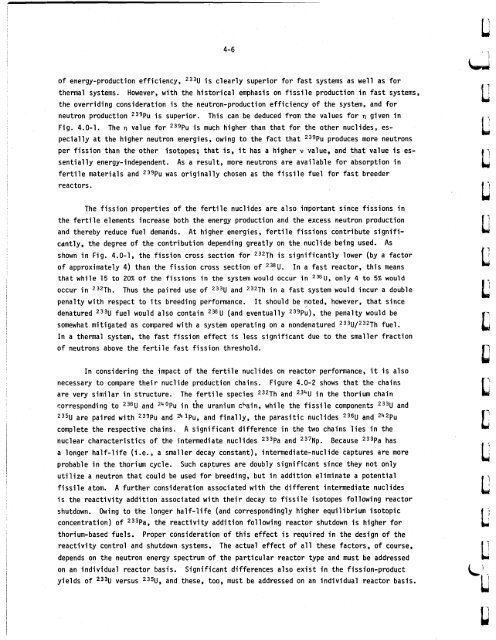ORNL-5388 - the Molten Salt Energy Technologies Web Site
ORNL-5388 - the Molten Salt Energy Technologies Web Site
ORNL-5388 - the Molten Salt Energy Technologies Web Site
Create successful ePaper yourself
Turn your PDF publications into a flip-book with our unique Google optimized e-Paper software.
4-6 ..<br />
of energy-production efficiency, 233U is clearly superior for fast systems as well as for<br />
<strong>the</strong>rmal systems.<br />
<strong>the</strong> overriding consideration is <strong>the</strong> neutron-production efficiency of <strong>the</strong> system, and for<br />
neutron production 239Pu is superior.<br />
Fig. 4.0-1.<br />
pecially at <strong>the</strong> higher neutron energies, owing to <strong>the</strong> fact that 239Pu produces more neutrons<br />
per fission than <strong>the</strong> o<strong>the</strong>r isotopes; that is, it has a higher v value, and that value is es-<br />
sentially energy-independent. As a result, more neutrons are available for absorption in<br />
fertile materials and 239Pu was originally chosen as <strong>the</strong> fissile fuel for fast breeder<br />
reactors.<br />
However, with <strong>the</strong> historical emphasis on fissile production in fast systems,<br />
This can be deduced from <strong>the</strong> values for q given in<br />
The rl value for 239Pu is much higher than that for <strong>the</strong> o<strong>the</strong>r nuclides, es-<br />
The fission properties of <strong>the</strong> fertile nuclides are also important since fissions in<br />
<strong>the</strong> fertile elements increase both <strong>the</strong> energy production and <strong>the</strong> excess neutron production<br />
and <strong>the</strong>reby reduce fuel demands. At higher energies, fertile fissions contribute significdntly,<br />
<strong>the</strong> degree of <strong>the</strong> contribution depending greatly on <strong>the</strong> nuclide being used. As<br />
shown in Fig. 4.0-1, <strong>the</strong> fission cross section for 232Th i s significantly lower (by a factor<br />
of approximately 4) than <strong>the</strong> fission cross section of 238U. In a fast reactor, this means<br />
that while 15 to 20% of <strong>the</strong> fissions in <strong>the</strong> system would occur in 238U, only 4 to 5% would<br />
occur in 232Th.<br />
Thus <strong>the</strong> paired use of 233U and 232Th i n a fast system would incur a double<br />
penalty with respect to its breeding performance. It should be noted, however, that since<br />
denatured 233U fuel would also contain 238U (and eventually 239Pu), <strong>the</strong> penalty would be<br />
somewhat mitigated as compared with a system operating on a nondenatured 233U/232Th fuel.<br />
In a <strong>the</strong>rmal system, <strong>the</strong> fast fission effect is less significant due to <strong>the</strong> smaller fraction<br />
of neutrons above <strong>the</strong> fertile fast fission threshold.<br />
In considering <strong>the</strong> impact of <strong>the</strong> fertile nuclides on reactor performance, it is also<br />
necessary to compare <strong>the</strong>ir nuclide production chains.<br />
are very similar in structure.<br />
.corresponding to 238U and 240Pu i n t'he uranium chain, while <strong>the</strong> fissile components 233U and<br />
235U are paired with 239Pu and 241Pu, and finally, <strong>the</strong> parasitic nuclides 236U and 242Pu<br />
complete <strong>the</strong> respective chains. A significant difference in <strong>the</strong> two chains lies in <strong>the</strong><br />
nuclear characteristics of <strong>the</strong> intermediate nuclides 233Pa and 237Np. Because 233Pa has<br />
a longer half-life (i .e. , a smaller decay constant), intermediate-nuclide captures are more<br />
probable in <strong>the</strong> thorium cycle. Such captures are doubly significant since <strong>the</strong>y not only<br />
utilize a neutron that could be used for breeding, but in addition eliminate a potential<br />
fissile atom. A fur<strong>the</strong>r consideration associated with <strong>the</strong> different intermediate nuclides<br />
is <strong>the</strong> reactivity addition associated with <strong>the</strong>ir decay to fissile isotopes following reactor<br />
shutdown. Owing to <strong>the</strong> longer half-life (and correspondingly higher equilibrium isotopic<br />
concentration) of 233Pa, <strong>the</strong> reactivity addition following reactor shutdown is higher for<br />
thorium-based fuels.<br />
reactivity control and shutdown systems. The actual effect of all <strong>the</strong>se factors, of course,<br />
depends on <strong>the</strong> neutron energy spectrum of <strong>the</strong> particular reactor type and must be addressed<br />
on an individual reactor basis.<br />
Figure 4.0-2 shows that <strong>the</strong> chains<br />
The fertile species 232Th and 234U in <strong>the</strong> thorium chain<br />
Proper consideration of this effect is required in <strong>the</strong> design of <strong>the</strong><br />
Significant differences also exist in <strong>the</strong> fission-product<br />
yields of 23311 versus 235U, and <strong>the</strong>se, too, must be addressed on an individual reactor basis.<br />
L<br />
Li<br />
L<br />
L<br />
c<br />
L]<br />
II



![Review of Molten Salt Reactor Physics Calculations [Disc 2]](https://img.yumpu.com/21979492/1/190x247/review-of-molten-salt-reactor-physics-calculations-disc-2.jpg?quality=85)












